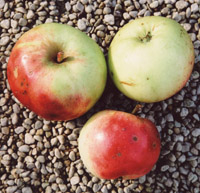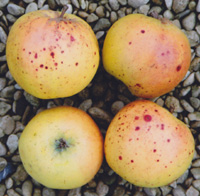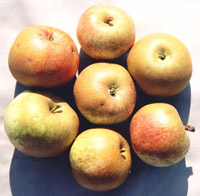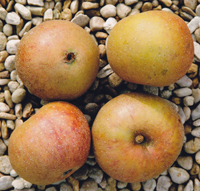
 |
|||||
|
|
|||||
|
|
|
|||||
|
|
 |
PITMASTON PINE APPLE A late dessert russet apple raised around 1785 by Mr White, who was steward to Lord Foley of Stoke Edith, Herefordshire. It is thought to have come from a seed of Golden Pippin. Another story is that it was raised by John Williams of Pitmaston in 1825. Small golden apples, produced prolifically and packed with flavours of pineapple and honey, in crisp, juicy and sweet flesh. The tree is moderately vigorous, with a good bushy habit and pretty blossom. A good and regular cropper. Pollination Group 4 |
||
 |
PITMASTON RUSSET NONPAREIL A small late russet dessert apple, known since 1818 when the tree first fruited, raised by John Williams at Pitmaston, near Worcester, around 1815. Lindley (1831) called it “a dessert apple of great merit in November and December”. He added that the skin is of a dull green, nearly covered with russet, a little mixed with yellow, and faint red on the sunny side. The juice is rich, with a high aromatic flavour, and the peculiar perfume of the Nonpareil. The apples keep until January. Pollination Group 4 |
|||
 |
PITSTONE
PIPPIN A chance seedling that grew on a 25ft long slope in an
old quarry at Pitstone, on the border of Buckinghamshire with Bedfordshire.
The quarry is now a nature reserve. Apples and scion-wood were brought
to us by Peter Revell, apple enthusiast and naturalist. We include it
for local interest, but it is also an excellent apple. It is probably
around 60 years old. A middle to late season cooking and eating apple
ripe in September, but later in some years. It is sharp when young. It
might also have some quality as a cider apple, though untested. Medium
to large sized with smooth, slightly glossy skin - green becoming pale
yellow, blushed and streaked with crimson. When cooked it breaks down
to release a very rich flavour but with slight tartness. It welcomes a
little sugar to bring out the flavour completely. Later on it becomes
a good dessert apple. The fruit stores into the New Year. Free flowering,
with pretty blossom. Pollination Group 4 |
|||
PLUM
VITAE Sent to us by Susan Rumney of East Devon, a triple purpose
early season apple, ripe in August and gone by October. Her tree is in
an orchard that went with a row of cottages, and has been in her family
for nearly 70 years. The tree looks significantly old but is healthy and
bears well. Her parents were told by a village ‘old boy’ that
it was called Plum Vitae and that it was a cider apple, though Susan and
her family eat them raw and cook them to a fluff. In 1883 it was exhibited
at RHS Chiswick with the name of Plum Vite, but Susan Rumney knows it
as Plum Vitae, which has also been noted as an alternative name elsewhere.
Pollination Group 2 |
||||
 |
POLECAT
The Polecat Public House, at Prestwood, Buckinghamshire, contained several
old and interesting apples in its extensive orchard garden, and we took
scions of all, with the permission of the former owner, John Gamble, in
2005. Unfortunately the new owners have removed most of the trees to enlarge
the car park.The fruits bore all the hallmarks of varieties planted to
provide both food and cider for the old Inn’s guests. The trees
were at least a century old and many very old. This tree bore small golden
apples, flushed or lightly streaked with pink/red and ripe in late September.
Sweet, crisp and juicy, with a rich flavour. Pollination Group 5 |
|||
 |
POLECAT
PEERLESS The Polecat Public House, at Prestwood, Buckinghamshire,
contained several old and interesting apples in its extensive orchard
garden, and we took scions of all, with the permission of the former owner,
John Gamble, in 2005. Unfortunately the new owners have removed most of
the trees to enlarge the car park.The fruits bore all the hallmarks of
varieties planted to provide both food and cider for the old Inn’s
guests. The trees were at least a century old and many very old. We have
named them after the Mustelid family of creatures. Polecat Peerless is
an excellent dual purpose apple that is ripe in late October and good
to eat raw. Sweet, quite lemony, crisp and juicy. When cooked it softens
quickly but keeps its shape and develops a very rich flavour, with no
need for added sugar. Pollination Group 4 |
|||
 |
POMEROY
OF HEREFORDSHIRE Given to us by Hilary Wilson who had it from
Philip Rainford of the Northern Fruit Group. Hogg recorded three different
Pomeroys though it was previously known that the name was used differently
in different regions. Hogg (1884) believed that the name Pomeroy (Pome-Roy,
or King’s Apple) went back to Norman Britain rather than being of
French origin. The Herefordshire Pomeroy is on the small side of medium
size, rounded and slightly angular, especially round the eye, sometimes
conical. The skin is greenish yellow, with some russet in the shade, and
deep crimson colouring and cinnamon russet in the sun. The flesh is yellow,
juicy and sweet with a good flavour. Ripe in September and storing for
a month or so. Probably very old. Pollination Group 3 |
|||
 |
POMEROY
OF SOMERSET Also known as Somerset Pomeroy, or The Old Pomeroy.
It was first described in 1851, but is undoubtedly much older. Pome-De-Roy
goes back to before 1570 and later variations in the naming were common
in the 17th century. A very good late dessert apple, medium-sized, with
greenish-yellow skin, covered with fine greyish russet, streaked red where
exposed to the sun and with large russet dots all over. The flesh is yellowish,
sweet, crisp, juicy and richly flavoured. Ripe in October, it stores until
December. Pollination Group 4 |
|||
 |
POMME
DE FER Literally, ‘apple of iron’, being a dense
apple, heavy in the hand. The first record of it in Britain was in the
1826 London Horticultural Society collection catalogue, though there is
some uncertainty if this is the same one. In France, where it is presumed
this apple originated, there are several apples with ‘Fer’
in the name. The French national collection has six, including Pomme de
Fer, De Fer and Fer. The one we have here is a most interesting apple
that is not only attractive to look at, but is a very useful late dessert
and cooking apple, that will keep for many months. The shape is rounded
and fairly flat, medium sized but sometimes large, and with skin that
carries a misty bloom, over pale yellow, with pink and raspberry streaks.
The texture of the flesh is fine but initially hard, and it is very late
to ripen fully, when it develops an unusual but pleasing sweet rich flavour.
It is not juicy, but is not dry. Early on, it is a bit too hard to cook
easily, but with maturity it softens, keeping all its shape, and having
a very sweet, rich lemony flavour. Pollination Group 4 |
|||
 |
POMME GRISE Forsyth tells us, in 1810, that “Pomme Grise, was introduced into this country by Mr. Alexander Barclay, of Brompton, well known for his ingenuity in bleaching of wax. He is a great lover of horticulture, and has raised several new sorts of Gooseberries from seed. This is a fine Apple, from Canada, of a flattish form and russet colour, streaked beautifully with red. It ripens late, and keeps till March. This is an excellent eating Apple.” Bunyard (1920) said that it came to England from Canada in 1794. Downing (1878) thought that it might originally have been French or Swiss, but there are no records in those countries to support it. Hedrich, in America in 1922 said that it had been cultivated more than a century in Canada and “finds greatest favor among the French in the valley of the St. Lawrence”. It might well be French and very old indeed, having been planted along the colonization routes of the French in Canada in the 17th or 18th century. Throughout the 19th century it was known and appreciated for the rich little apple that it is, but it has been unknown here, after Bunyard wrote of it in 1920. It has lived on in America, throughout, and is also now in the Belgian national collection, but not encountered elsewhere. Hogg in 1884 described it as a dessert apple, small, roundish/ovate, with skin covered in rough russet. Underneath the russet it is green in the shade, but orange in the sun. The flesh is tinted yellow, crisp, very juicy and sugary, with a brisk and highly aromatic flavour. The eye is small and open, set in a narrow and shallow basin. The stalk is about half an inch long, inserted in a shallow and small cavity. This is the apple that is known in America and our experience of it, having been sent scions from the collection of the late Nick Botner, in Oregon, in 2001. Apples here are ripe in early October, when they are gently crisp and crunchy, very sweet, richly flavoured with just the right amount of acid and bursting with juice. The skin is covered with broken russet, and it can be a little tough, but not enough to deter the pleasure inside. The apples will store over the winter. Pollination Group 4 | |||
|
||||